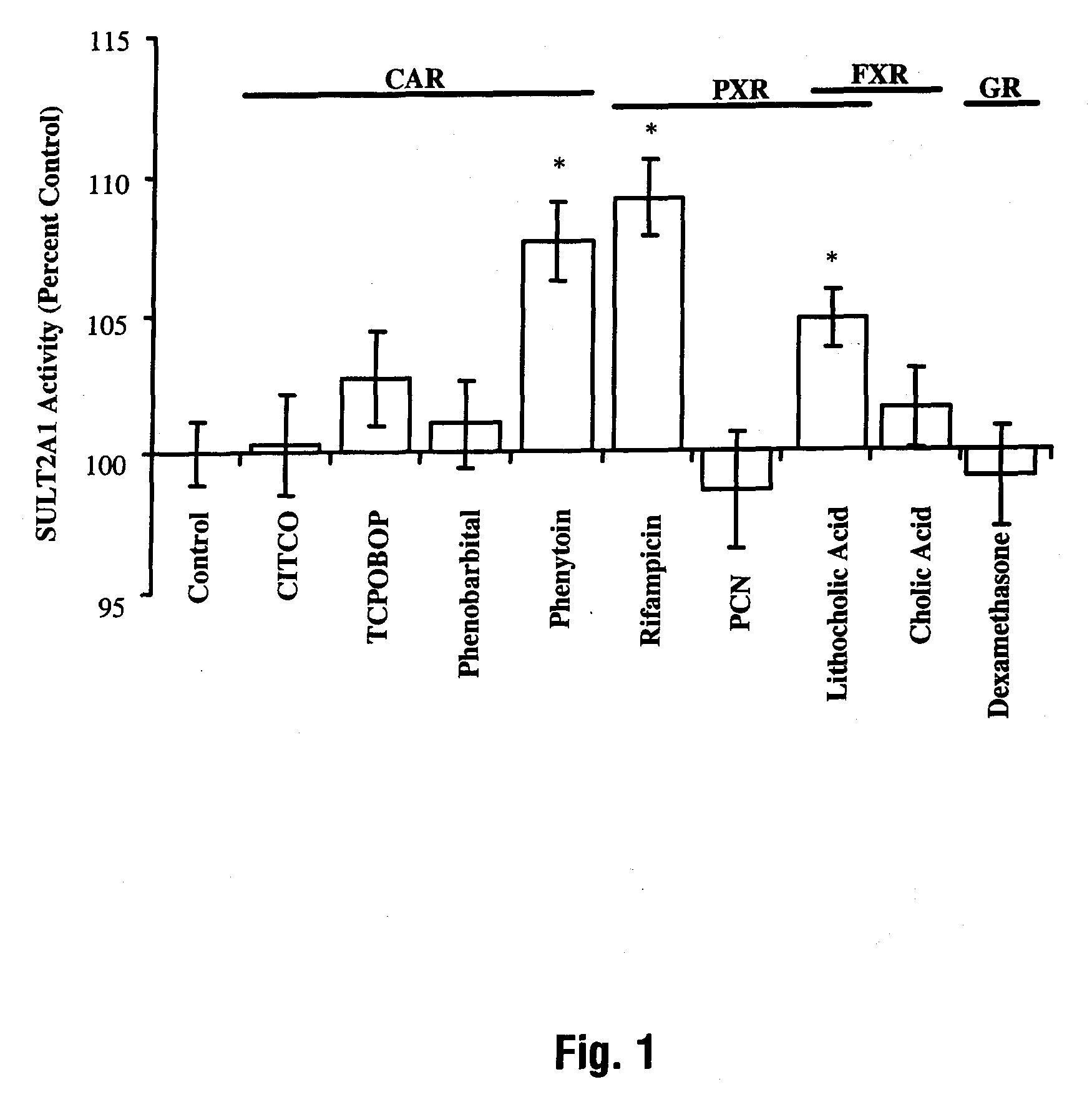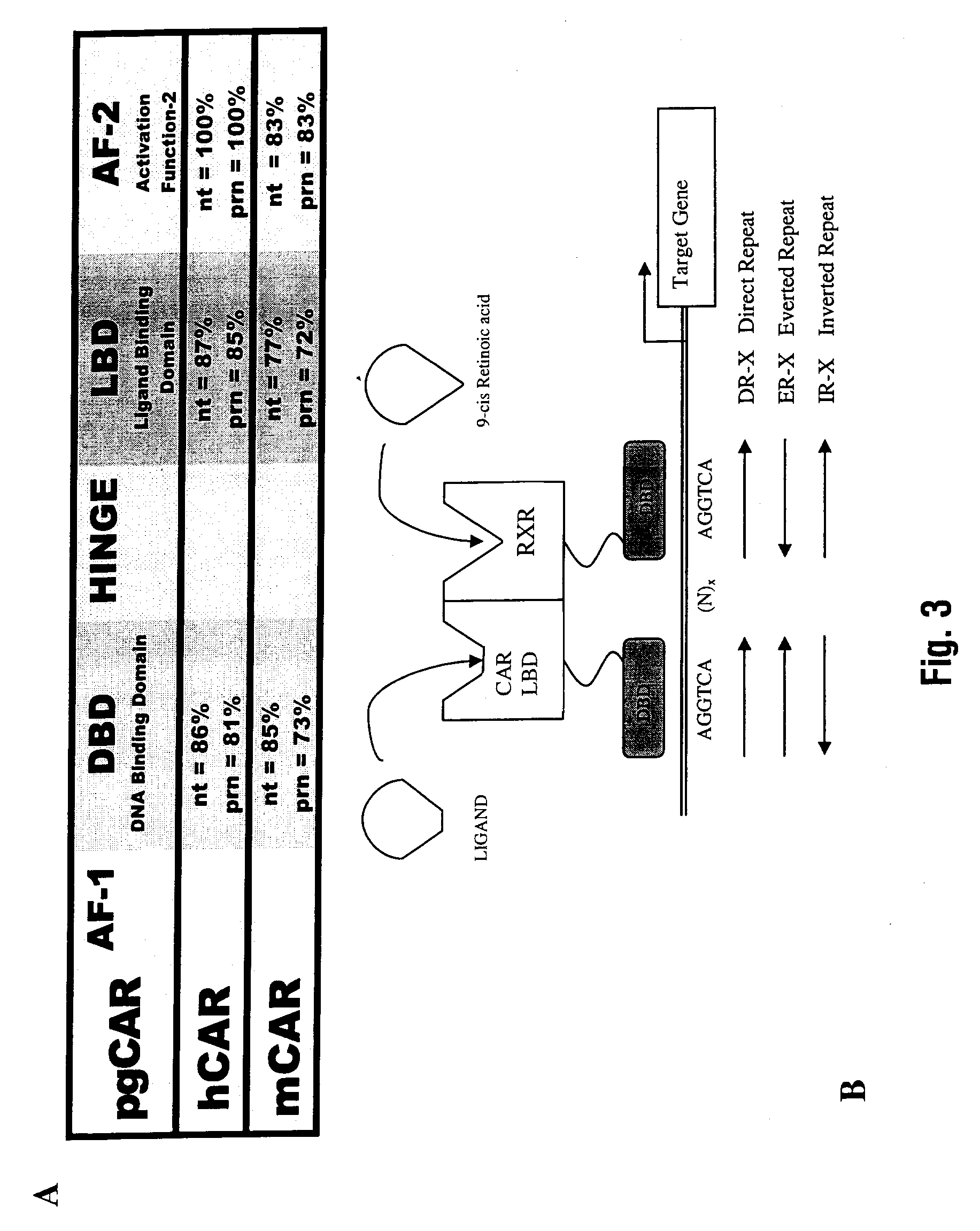Method of detecting and reducing boar taint using nuclear receptors
- Summary
- Abstract
- Description
- Claims
- Application Information
AI Technical Summary
Benefits of technology
Problems solved by technology
Method used
Image
Examples
example 1
The Role of Nuclear Receptors in SULT2A1 Expression and Sulfoconjugation of Androstenone
Introduction
[0144]Hydroxysteroid sulfotransferase (SULT2A1) is responsible for sulfoconjugating the 16-androstene steroids (Sinclair & Squires 2005), which have pheromonal properties and are the most abundant steroids produced by the boar testes. The accumulation of high levels of the 16-androstene steroid, 5α-androstenone, in adipose tissue produces an unpleasant odor when the meat from intact males is cooked (Patterson 1968). Our previous studies have indicated that increased levels of sulfoconjugated 16-androstene steroids present in the systemic circulation are associated with a reduction in the accumulation of 5α-androstenone in adipose tissue (Sinclair & Squires 2005). In humans, SULT2A1 activity varies up to 5-fold among individuals (Weinshilboum & Aksoy 1994), suggesting that genetic polymorphisms may be involved in regulating SULT2A1 activity. A number of studies reported single nucleoti...
example 2
Role of Nuclear Receptors on CYP2A6 and CYP2E1 Activity and the Metabolism of Skatole in Pig Liver
Abstract
[0175]Hepatic cytochrome P450 (CYP) 2E1 and CYP2A6 have been shown to play a role in the metabolism of skatole in pigs. This study investigates the role of CYP2E1 and CYP2A6 enzymes in hepatocytes from adult and 3-week old intact male pigs. We treated hepatocytes with isoproterenol, testosterone, estradiol, estrone, androstenol and androstanol, and with a constitutively activated androstane receptor (CAR) and pregnane X receptor (PXR) agonists, 6-(4-chlorophenyl) imidazo[2,1-b][1,3]thiazole-5-carbaldehyde O-(3,4-dichlorobenzyl)oxime (CITCO) and rifampicin respectively. We found that hepatocytes from 3-week old males treated with isoproterenol and with rifampicin caused an alteration in CYP2E1 and CYP2A6 activities respectively, while also increasing the metabolism of 3MI metabolites HMOI and 3MOI. In comparison, only isoproterenol was able to increase HMOI production in adult ...
example 3
The Role of Nuclear Receptor CAR in Boar Taint
Abstract
[0195]The boar taint phenotype is caused by an accumulation of androstenone and / or skatole in pig fat causing an off or fecal odor in the meat. The nuclear receptor CAR (Constitutive Active / Androstane Receptor) controls the metabolism of lipophilic compounds like hormones and drugs by regulating the expression of phase I and phase II metabolic enzymes. CAR may also be involved in the regulation of the metabolism of boar taint compounds. The goal of this project was to characterize pig CAR (pgCAR) and determine if it was regulated by the same hormonal ligands as in human and mouse; further to determine if this regulation is involved in the accumulation of androstenone and / or skatole in pig fatty tissues. We have shown that pig CAR is 87% homologous to human CAR (hCAR), and it could be used as a better model species than mouse for CAR studies in humans, since pgCAR responds to the same ligand treatments and is more sensitive than h...
PUM
| Property | Measurement | Unit |
|---|---|---|
| Fraction | aaaaa | aaaaa |
| Fraction | aaaaa | aaaaa |
| Fraction | aaaaa | aaaaa |
Abstract
Description
Claims
Application Information
 Login to View More
Login to View More - R&D
- Intellectual Property
- Life Sciences
- Materials
- Tech Scout
- Unparalleled Data Quality
- Higher Quality Content
- 60% Fewer Hallucinations
Browse by: Latest US Patents, China's latest patents, Technical Efficacy Thesaurus, Application Domain, Technology Topic, Popular Technical Reports.
© 2025 PatSnap. All rights reserved.Legal|Privacy policy|Modern Slavery Act Transparency Statement|Sitemap|About US| Contact US: help@patsnap.com



